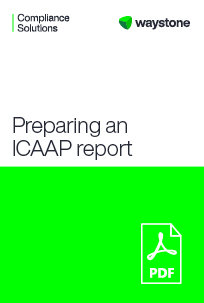
IRAP & ICAAP
The IRAP and ICAAP processes enable effective risk management and informed strategy decisions.
Regulators expect firms to understand the risks faced by their business operations and to ensure that it is adequately capitalised to be able to withstand such risks, even under stressed situations. To ensure that senior management appreciates the link between capital and risk, regulators require the firm to produce one or both of the following:
- an Internal Risk Assessment Process (IRAP)
- an Internal Capital Adequacy Assessment Process (ICAAP).
Internal Risk Assessment Process (IRAP)
Also referred to as the Enterprise Risk Management (ERM) Framework, the IRAP is used to identify and assess all the risks to which the firm is exposed, to weigh those risks as to the potential impact on the business, to consider the control environment around those potential risks and then to determine whether the residual risk is in line with the risk appetite of the firm. The analysis must be performed at senior management level and then documented in a report which should be considered and addressed by the board. This is a significant process but if performed well provides essential information to enable the firm to manage its risks.
At a minimum, the IRAP report should include the following sections:
- executive summary
- high level overview of the process followed in performing the IRAP
- structure and governance of the risk management function
- statement of risk appetite
- key risks with a cross reference to the risk register
- capital planning and sufficiency
- stress testing and scenario analysis
- integration, review and approval.
Internal Capital Adequacy Assessment Process (ICAAP)
The ICAAP builds on the IRAP by estimating the amount of capital your firm needs to absorb any likely losses and to address your growth plans, enabling you to form an overall view of the amount and quality of capital you should hold and ensuring that the required amounts and types of capital are available. The regulator will also use this calculation as part of their minimum capital requirements that are imposed on the firm.

Preparing an ICAAP report
The ongoing evolution of the Basel regime, means that understanding and implementing new requirements can be challenging. For more details on the preparation of the ICAAP report, download our Knowledge Series piece.
How can Waystone help?
Performed correctly, the IRAP and ICAAP processes will provide your senior management and your board of directors with sufficient information to enable effective management of risks and to allow for more informed decisions as to future strategy in response to market events. The amount of work and analysis required to produce the report should not be underestimated, however, Waystone can support you by:
- project managing and carrying out the entire IRAP and ICAAP processes, including reporting to management
- assisting with developing the financial models to quantify the capital impact of potential risks
- assisting in designing and developing appropriate stress tests and scenarios as required by prudential requirements of your regulator
- performing independent quality assurance review to ensure there are adequate internal controls over the integrity and objectivity of the process
- assisting with the implementation of risk management process enhancements, including risk assessment, risk measurement and monitoring, and risk reporting
- keeping your firm updated on changes to reporting requirements.
What should you do now?
For assistance with completing your IRAP and ICAAP, contact our regulatory return specialists below.